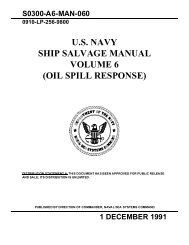April 2007 - Supervisor of Salvage and Diving
April 2007 - Supervisor of Salvage and Diving
April 2007 - Supervisor of Salvage and Diving
Create successful ePaper yourself
Turn your PDF publications into a flip-book with our unique Google optimized e-Paper software.
The U.S. Navy’s “Revolution in<br />
Training” <strong>and</strong> implementation <strong>of</strong> the<br />
NAVY DIVER (ND) rating required an<br />
extensive review <strong>of</strong> Diver training to<br />
validate <strong>and</strong> align training with Navy<br />
mission requirements. The result was a<br />
blended solution <strong>of</strong> formal training, online<br />
computer based training, personnel<br />
qualification st<strong>and</strong>ards <strong>and</strong> on-the-job<br />
training forming an independent training<br />
pipeline that delivers trained Divers to<br />
the Fleet in increasing numbers.<br />
One <strong>of</strong> the largest concerns, <strong>and</strong> a<br />
continuing challenge, is the high attrition<br />
associated with the training pipeline. In<br />
the fall <strong>of</strong> 2006, a new preparatory course<br />
<strong>of</strong> instruction was implemented to address<br />
high attrition areas. Located at Great<br />
Lakes, IL, the new NAVY DIVER PRE-<br />
PARATORY (A-433-0101) course <strong>of</strong><br />
instruction is designed to reduce attrition<br />
<strong>and</strong> increase student graduation success<br />
rates during traditionally difficult phases<br />
<strong>of</strong> training. The 32 day course combines<br />
pieces <strong>of</strong> the Basic Engineering Common<br />
Core (BECC) course, intense physical<br />
training, <strong>and</strong> in-water instruction. The<br />
course includes computer based instruction<br />
in basic engineering principles, systems,<br />
procedures, <strong>and</strong> h<strong>and</strong>s-on laboratory<br />
training, as well as CPR, basic diving<br />
physics, basic diving physiology <strong>and</strong><br />
medicine, <strong>and</strong> dem<strong>and</strong>ing physical training.<br />
Upon successful completion <strong>of</strong> the<br />
preparatory course, diving c<strong>and</strong>idates<br />
report to the Navy <strong>Diving</strong> <strong>and</strong> <strong>Salvage</strong><br />
Training Center, Panama City, FL to begin<br />
the Second Class Diver training. The<br />
Second Class Diver course has been extensively<br />
revised to better meet Fleet requirements,<br />
reduce student attrition, <strong>and</strong><br />
better prepare apprentice Divers for their<br />
first tour in the Fleet. Classroom <strong>and</strong><br />
practical training phases have been added<br />
in basic demolition operations, MK-16<br />
mixed gas diving, <strong>and</strong> MK-25 rebreather<br />
diving. Traditional areas <strong>of</strong> physics, medicine,<br />
salvage, underwater cutting <strong>and</strong><br />
welding remain in the course. One <strong>of</strong> the<br />
major changes in the construct <strong>of</strong> the<br />
course is the movement <strong>of</strong> SCUBA training<br />
from the 2nd week <strong>of</strong> training to the<br />
10th. This change enables c<strong>and</strong>idates to<br />
be more familiar with the diving environment<br />
<strong>and</strong> more confident when conducting<br />
traditional SCUBA problem solving<br />
in the pool.<br />
Upon graduation, new Second Class<br />
Divers are sent to the fleet to ply their trade<br />
<strong>and</strong> earn their warfare qualifications.<br />
Upon DSWS qualification at their first<br />
comm<strong>and</strong>, personnel are awarded <strong>and</strong> can<br />
begin wearing the traditional breast insignia<br />
as their warfare device. Second Class<br />
Divers must complete two tours in the<br />
Fleet before becoming eligible to attend<br />
First Class Dive School (A-433-0025),<br />
including a tour at a ship repair comm<strong>and</strong><br />
or a salvage comm<strong>and</strong>. Other prerequisites<br />
for attending First Class Dive School<br />
include paygrade E-5 or above, Diver<br />
<strong>Salvage</strong> Warfare Specialist (DSWS)<br />
qualified, <strong>and</strong> additional MILPERSMAN<br />
requirements.<br />
The First Class Diver course <strong>of</strong><br />
instruction is 65 days in length <strong>and</strong> is<br />
designed to train qualified Second Class<br />
Divers to become <strong>Diving</strong> <strong>Supervisor</strong>s in<br />
the Fleet. The course includes advanced<br />
training in diving physics <strong>and</strong> calculations,<br />
diving medicine, recompression chamber<br />
supervision, supervision <strong>of</strong> demolition<br />
operations, surface supplied mixed gas<br />
diving, <strong>and</strong> supervisory casualty control<br />
procedures for all diving rigs.<br />
After graduation, new First Class<br />
Divers are ordered to their first Fleet<br />
assignment <strong>and</strong> expected to qualify <strong>and</strong><br />
perform as a <strong>Diving</strong> <strong>Supervisor</strong>. Gaining<br />
experience along the way, First Class<br />
Divers should strive to prepare themselves<br />
for attending Master Diver evaluations<br />
(A-433-0019). The requirements to<br />
attend MDV evaluations are outlined in<br />
MILPERSMAN 1220 <strong>and</strong> include a<br />
minimum <strong>of</strong> 2 tours <strong>of</strong> duty as a First Class<br />
Diver, DSWS qualifications, <strong>Diving</strong><br />
<strong>Supervisor</strong> qualifications, <strong>and</strong> completion<br />
<strong>of</strong> the on-line Navy Diver <strong>Salvage</strong> Course<br />
via Navy E-learning.<br />
Both Second <strong>and</strong> First Class Divers<br />
are required to qualify DSWS. Second<br />
Class Divers have 24 months from arrival<br />
at their first comm<strong>and</strong> with required<br />
requalification within 18 months <strong>of</strong> arrival<br />
at subsequent comm<strong>and</strong>s. First Class<br />
Divers have 18 months for their initial <strong>and</strong><br />
all subsequent qualifications. DSWS<br />
qualifications for First Class Divers now<br />
require that they qualify diving supervisor<br />
at their comm<strong>and</strong>. Failure to complete<br />
these requirements (or requalification)<br />
could result in loss <strong>of</strong> NEC, rating, <strong>and</strong><br />
promotion.<br />
When a Diver becomes physically<br />
(medically) disqualified to perform his/her<br />
duties as a Navy Diver, they will appear<br />
before a board. They may become eligible<br />
for reclassification to another source rating,<br />
or in some cases, depending on his<br />
rank (E-7 <strong>and</strong> above), may be placed in a<br />
supervisory position for his/her tenure.<br />
C<strong>and</strong>idates eligible to attend the<br />
Master Diver Course are notified <strong>of</strong><br />
eligibility by PERS-401 DC <strong>and</strong> must<br />
submit an application to attend the<br />
Master Diver Evaluation Course. This 25<br />
day course has been extensively revised<br />
<strong>and</strong> includes advanced instruction in the<br />
planning <strong>and</strong> management <strong>of</strong> diving,<br />
salvage, underwater ship repair operations,<br />
systems certifications & quality assurance,<br />
<strong>and</strong> extensive performance testing<br />
supervising at sea diving operations.<br />
Captain Gary Windhorst is Comm<strong>and</strong>ing Officer <strong>of</strong><br />
the Center <strong>of</strong> Explosive Ordinance Disposal <strong>and</strong><br />
<strong>Diving</strong> (CEODD). NDCM (MDV) Dryden is<br />
currently an MDV at CEODD.<br />
A p r i l 2 0 0 7 9

















